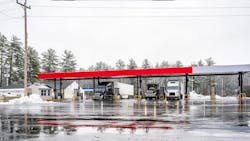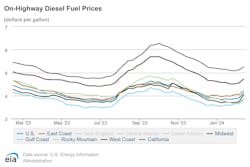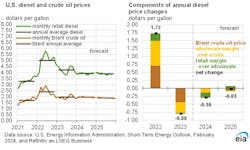Diesel prices spike in earnest, crude oil costs expected to rise
After three weeks of plateaued or incremental diesel fuel prices, the week of Feb. 13 saw a sharp rise in fuel costs across the country. According to the U.S. Energy Information Administration, the national average for on-highway diesel fuel prices reached $4.109 per gallon. While 33 cents lower than this time last year, this reflects a 21-cent price hike from the week before and the first time costs have broken $4 since early December 2023.
This increase in national fuel costs was mirrored in all regions and sub-regions across the U.S., all of which also saw a steeper price increase than prior weeks. While previous rises in price generally stayed in the single digits, this week's cost changes ranged from 2 to 30 cents at a time. The New England sub-region saw the smallest increase of 2 cents, up to $4.350 per gallon, closely followed by its sister sub-region in the Central Atlantic, which saw diesel prices rise by 4 cents, to $4.317.
But for larger areas, California saw the smallest price increase of 12 cents up to $5.250 per gallon, and the Rocky Mountain region saw the second-smallest price increase of 15 cents. Meanwhile, the Midwest experienced the largest price increase of 30 cents, pushing on-highway diesel costs up to $4.042 per gallon. The West Coast without California and the Lower Atlantic subregion also saw substantial price hikes of 21 cents, adding up to prices of $4.264 per gallon and $4.143, respectively.
With these prices increases, the Rocky Mountain region is currently the cheapest place to buy diesel fuel at $3.806, beating out the Gulf Coast by 6 cents. California is still the most expensive at $5.250.
In comparison to the EIA’s numbers, the AAA motor club logged diesel prices of $4.004, cheaper than current EIA counts and 7 cents more than last week’s average of $3.932 per gallon. It is still cheaper than last year’s rates of $4.563 per gallon.
See also: Gas and diesel prices rise with the temperature
The increase in prices could also be due to a fall in U.S. oil production, which the EIA’s most recent Short-Term Energy Outlook said dropped to 12.6 million barrels per day in January due to the cold weather. The report also found that current disruptions in the Middle East could lead to higher crude oil prices, as have current vessel attacks in the Red Sea, potentially pushing prices over $80 per barrel.
But despite these projections, the report overall expects retail diesel rates to hover around the average annual for diesel as the year progresses.
Gasoline prices less drastic than diesel
While regular gasoline prices also increased over the past week, their change was largely less drastic than those seen in diesel. The EIA found that the national gasoline price average is $3.192 per gallon for the week of Feb. 13, an increase of only 5 cents from a week ago and nearly 20 cents lower than last year.
Gasoline prices also rose in every region save for the Gulf Coast, which decreased by just over 1 cent to $2.807, and the West Coast without California, which declined by less than 1 cent to $3.564 per gallon. Otherwise, various U.S. regions saw price hikes from 1 cent up to 13, with the largest price increase occurring in the Midwest up to $3.044 per gallon. The smallest gasoline price increase is 1 cent in the New England sub-region, followed by a 2-cent increase for the West Coast including California. The Rocky Mountain region is once again the cheapest place for gasoline at $2.791 per gallon, while California is the most expensive at $4.422.
The motor club also tracked a 5-cent increase in gasoline prices from last week, recording a current nationwide fuel average of $3.196 per gallon, but 22 cents cheaper than last year’s gas prices of $3.419.
According to a press release from the motor club, seasonal demand, higher oil costs, and refinery maintenance may contribute to pushing prices up, albeit at a slower pace than diesel fuel.
“It feels like being in a car with a cold battery, cranking away yet slow to turn over,” said Andrew Gross, AAA spokesperson. “But gas prices will likely start increasing around Valentine’s Day.”
About the Author
Alex Keenan
Alex Keenan has been associate editor for Endeavor's Commercial Vehicle Group, which includes FleetOwner magazine, since 2022. She has written on a variety of topics for the past several years and recently joined the transportation industry, reviewing content covering technician challenges and breaking industry news. She holds a bachelor's degree in English from Colorado State University in Fort Collins, Colorado.



